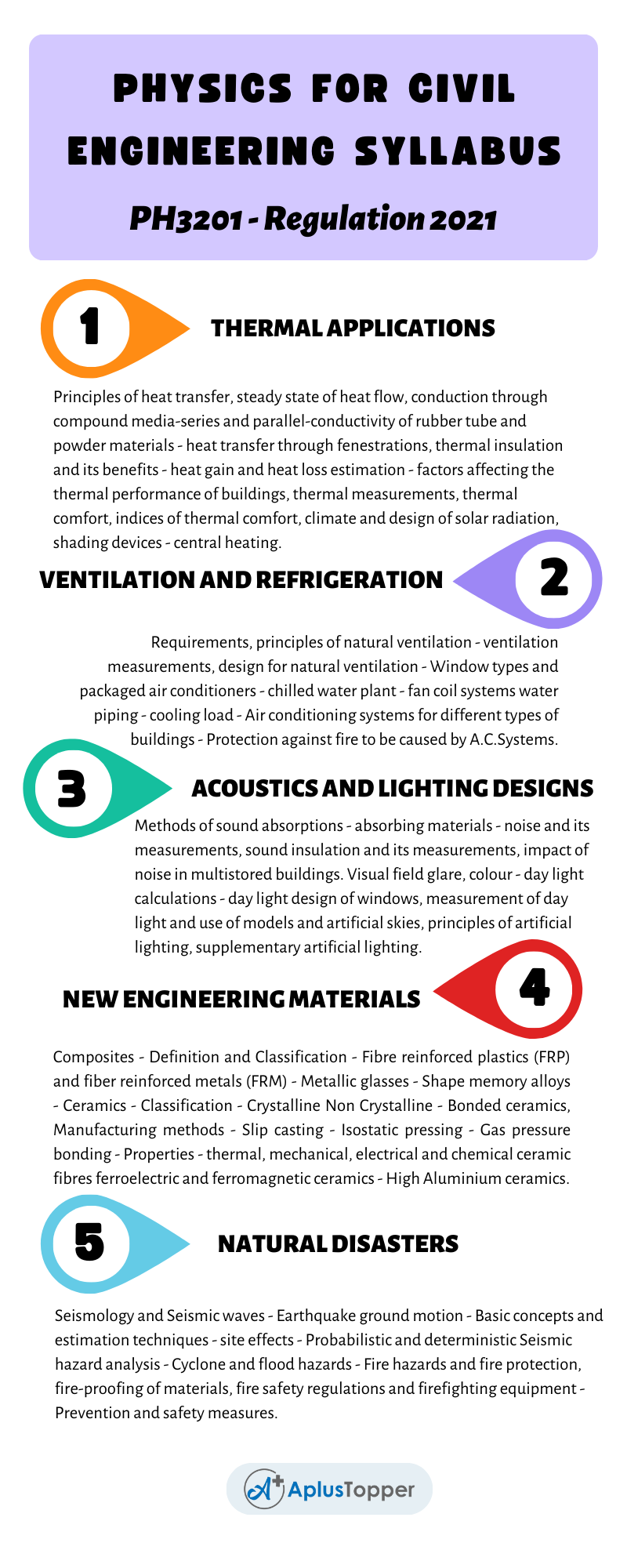Anna University, Subject code – PH3201, deals with the B.E civil Engineering Semester – II Physics For Civil Engineering syllabus regulation 2021 relating to affiliated institutions. From here, Students can get assistance in preparing notes to excel in academic performance.
We include every topic of the Physics For Civil Engineering Syllabus, to understand the subject very well. It will help you to improve your idea of syllabus of PH3201-Physics For Civil Engineering Syllabus on your finger tips to go ahead in a clear path of preparation. In this following article Physics For Civil Engineering Syllabus, will help you, Hope you share with your friends.
If you want to know more about the syllabus of B.E Civil Engineering connected to an affiliated institution’s under four-year undergraduate degree programme. We provide you with a detailed Year-wise, semester-wise, and Subject-wise syllabus in the following link B.E Civil Engineering Syllabus Anna University, Regulation 2021.
Aim Of Concept:
- To introduce the basics of heat transfer through different materials, thermal performance of building and various thermal applications
- To impart knowledge on the ventilation and air conditioning of buildings
- To introduce the concepts of sound insulation and lighting designs
- To give an introduction to the processing and applications of new engineering materials
- To create an awareness on natural disasters and safety measures
PH3201-Physics For Civil Engineering Syllabus
Unit I: Thermal Applications
Principles of heat transfer, steady state of heat flow, conduction through compound media-series and parallel-conductivity of rubber tube and powder materials – heat transfer through fenestrations, thermal insulation and its benefits – heat gain and heat loss estimation – factors affecting the thermal performance of buildings, thermal measurements, thermal comfort, indices of thermal comfort, climate and design of solar radiation, shading devices – central heating.
Unit II: Ventilation And Refrigeration
Requirements, principles of natural ventilation – ventilation measurements, design for natural ventilation – Window types and packaged air conditioners – chilled water plant – fan coil systems water piping – cooling load – Air conditioning systems for different types of buildings – Protection against fire to be caused by A.C.Systems.
Unit III: Acoustics And Lighting Designs
Methods of sound absorptions – absorbing materials – noise and its measurements, sound insulation and its measurements, impact of noise in multistored buildings. Visual field glare, colour – day light calculations – day light design of windows, measurement of day light and use of models and artificial skies, principles of artificial lighting, supplementary artificial lighting.
Unit IV: New Engineering Materials
Composites – Definition and Classification – Fibre reinforced plastics (FRP) and fiber reinforced metals (FRM) – Metallic glasses – Shape memory alloys – Ceramics – Classification – Crystalline Non Crystalline – Bonded ceramics, Manufacturing methods – Slip casting – Isostatic pressing – Gas pressure bonding – Properties – thermal, mechanical, electrical and chemical ceramic fibres ferroelectric and ferromagnetic ceramics – High Aluminium ceramics.

Unit V: Natural Disasters
Seismology and Seismic waves – Earthquake ground motion – Basic concepts and estimation techniques – site effects – Probabilistic and deterministic Seismic hazard analysis – Cyclone and flood hazards – Fire hazards and fire protection, fire-proofing of materials, fire safety regulations and firefighting equipment – Prevention and safety measures.
Text Books:
- Marko Pinteric, Building Physics, Springer 2017.
- D.S.Mathur. Elements of Properties of Matter. S Chand & Company, 2010.
- Hugo Hens, Building Physics: Heat, Air and Moisture, Wiley, 2017
References:
- W.R.Stevens. Building Physics: Lighting. Pergamon Press, 2013.
- Hugo Hens, Applied Building Physics, Wiley, 2016
- K.G.Budinski and M.K.Budinski. Engineering Materials: Properties and Selection. Pearson Education, 2016.
- Peter A. Claisse, Civil Engineering Materials, Elsevier, 2016.
- Patrick L. Abbott, Natural Disasters, McGraw-Hill, 2017.
Related Posts Of Semester – II:
